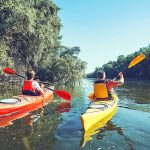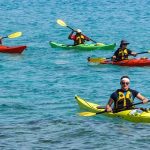As you move through the water, you will be mesmerized by the natural beauty and tranquility of your surroundings. Paddleboarding on rivers can be a great experience. You can launch into the water and follow the bends and flow.
You can head towards the unknown with each stroke. The variety of conditions can keep you on your toes. You can test your stand-up paddle board skill with eddies and rapids.
Paddleboarding can be dangerous and challenging on rivers, so safety should always be your top priority.
The most important thing you can do to stay safe while stand up paddle boarding on a river is to be aware of your surroundings and have faith in your equipment. We’re providing you with some tips to help you have a safe and enjoyable experience.
Here are some tips and tricks to help make your experience paddling on rivers more fun and safe!
Whether you need to learn river-specific terminology or what kind of gear works best, we have you covered. Keep reading for more information on how to paddle board effectively on rivers.
Preparing to Paddle Board on a River
Being prepared is essential to achieving success in all aspects of life. You need to think about some key aspects:
- Skill– are you capable of paddling on a river?
- SUP and equipment– is your gear suitable for river paddle boarding?
- Terrain – what are the water conditions along the river you plan to paddle?
But regardless of how you’re getting your SUP fix, make sure you have the right gear. Paddle boards, like any other piece of sports equipment, need to be high-quality and reliable in order to have a good experience.
Whether you already have a paddle board, are looking to buy one, or are still renting, make sure you have the right gear for the best experience.
There are some paddle boards that are designed specifically for use in rivers. If you plan on paddling in rivers often, you should look into getting one of these boards to get the most out of your experience.
Paddling on rivers is different from other bodies of water, such as lakes and oceans. You might need to modify your paddle board gear to be suitable for the terrain.
Skill for Paddle Boarding on Rivers
Paddling on rivers is different than paddling on flat water lakes and calm bays in the ocean because the water moves.
Even though it’s easy to paddle slow water, you need to be more confident and have better skills to paddle in rivers with fast water.
We recommend that real beginners and first-time paddle boarders stick to the lakes or other calm waters. Once they’ve mastered balancing and their paddle stroke technique, they can think about trying out a river.
Start by hitting a gentle and meandering river. After you have the hang of it, try taking it up a notch by adding some white water rapids to simulate SUP surfing on ocean waves.
Inflatable Paddle Boards
Inflatable paddle boards are much better for paddling on a river than epoxy fiberglass hardboards. They can handle rough terrain and conditions much better. Good quality inflatable paddle boards will bounce off rocks, roots, and other obstacles, whereas epoxy fiberglass could crack and ding.
When paddle boarding in rivers, the best kind of board to have is one with a rounded nose at the front. This allows for more maneuverability when trying to navigate through the river.
The middle section of the paddle board needs to be wide, typically around 30 to 32 inches, in order to be suitable for most river paddle boarding activities.
However, if you need extra stability, such as for whitewater rapids, you may want to consider a paddle board that is 35 inches wide.
A flatter rocker is better for smooth water, allowing the kayak to track more effectively The rocker is the upward curve of the nose above the water. A steep rocker is good for choppier conditions, giving you more stability, but it reduces your overall speed.
A flatter rocker is better for smooth water, allowing the kayak to track more effectively.
The GILI Air Inflatable Stand Up Paddle Board is perfect for users of any skill level who want to paddle board on rivers. The dimensions and shape of the board can handle the changing conditions found on rivers.
River Fins
Fins are fundamental.
If you’re planning to paddle board on a river, you’ll need to use shorter fins, called skegs. This is to avoid hazards in shallow waters. You’ll still need to use three fins to provide good tracking. Using shorter river fins is much safer than using a nine inch center fin.
Need some help finding a set of river fins? Here are two excellent choices made with the same quality and standard as all other GILI SUP gear:
- GILI 3” Snap In River Fin
- 3” River Fin (US fin box)
These fins are shorter than the stock fins, but they will still allow you to maneuver easily. You won’t have to worry about scraping the riverbed as often.
The flexibility of many river fins means that they can bend to some degree, which is useful for avoiding damage to the fin box or fin when swimming in shallow water with lots of debris.
Researching the Terrain
There are different dangers to consider when paddling a SUP in a river as opposed to a lake or ocean, so it is very important to research the area before setting out.
Things you need to know include:
- Launch and exit points
- Speed the water is flowing
- Calm water or rapids
- Changes in the current (direction of water)
- Eddies (a section of water moving in the opposite direction, usually caused by a rock underneath)
- Forks in the river, directions you need to take
- Water depth
- Tree branches above or tree roots below
- Wildlife
- Other boats and river users
In other words, being prepared is the best way to avoid having to swim home alone.
Insider Secrets From Top River Running Experts
Dan, Mike, and Britney are experienced and successful paddlers who love discussing the sport. I asked for their tips for aspiring river stand-up paddlers, and here is what they said:
Dan Gavere
If you want to paddle your stand-up paddle board in whitewater, it’s important to build a foundation of skills. The first is to learn how to identify and catch eddies.
Slack water is found behind rocks, obstacles, and river bends. “Eddy out” and “peel out” of eddies is a skill every paddler must learn in order to be successful in whitewater paddling.
Eddies not only allow you to stop and rest, but also to scout and maneuver through difficult sections. They can also be used to set yourself up to catch a river wave. River surfing is much easier when catching waves from an eddy.
If you can’t catch an eddy, you will never catch a river wave, let alone get back upstream to surf it again.
The next skill you need to learn for whitewater SUP is how to ferry. This lets you move from one side of the river to the other without going downstream.
You need to master this skill to surf river waves. You can learn these techniques in an intro to whitewater skills course, or by watching videos online.
Mike Taveres
If you want to try paddling on a SUP board, you should start small by finding a river with class I or II whitewater. Don’t try to paddle on a river that’s too difficult for you, or you may have problems.
Even if you’re experienced at paddling on Class III and IV whitewater, you can still have fun on small rapids.
One way to become better at whitewater rafting is to practice on easy rapids until you can navigate them well, and then challenge yourself by adding new, more difficult moves.
The ability to swim and manage gear are both key skills for safely navigating rivers. Swimming through easy rapids with and without gear is a good way to practice.
When in the river, always follow the golden rule and never stand up in moving water. Learning from a whitewater professional is the best way to ensure safety.
Britney Parker
As a beginner, you should start with your feet about hip-width apart, pointed slightly out, and straddle the handle in the center of the deck. This will make it easier to balance yourself if anything throws you off.
Getting used to the weight shift on your board will help you get comfortable on the trim of the board. You can try more advanced stances, like staggering your feet, when you are more comfortable.
This will come in handy when you need to react quickly and make sudden moves around obstacles.
Your paddle will stabilize you on your board, similar to how a third leg would stabilize a tripod. Therefore, you should keep your paddle in the water as much as possible to balance yourself.
If you come across choppy water, paddle through it to maintain your momentum.
If you fall into the rapids, it’s best to land on your board. Your board is usually safer than the river itself. When you’re falling, try to make your body as flat as possible. The depth of the river can fluctuate and you never know how close to the surface the rocks are.
The last thing you want to do is jump off your board feet first, as this can easily result in a broken leg or foot.
Keep hold of your paddle, put your feet up, and come down head first! As soon as your head pops up, check that there is no immediate danger ahead of you, swim quickly to your board, and start paddling again.
Remember, these are just tips and it’s best to go with an experienced or professional guide/instructor until you become confident with your paddling technique and familiar with the river.
I can’t stress enough to my students how important it is not to stand up in the river. It can be your first instinct when you fall off your board in waist-deep water, but I promise you it’s the last thing you want to do when you’re in the middle of a fast-moving current.
Foot entrapments are very serious and almost an impossible rescue. Your feet become wedged between rocks and the current continues to push you downstream, bringing your head underwater and not allowing you to come up for air.
To avoid foot entrapments, keep those feet up and pointed downstream until you can safely swim to your board.




